Jennifer Bohnhoff's Blog, page 29
May 4, 2020
My New Shadow
 In
Super Hec
, which is on sale on Amazon right now, nerdy middle schooler Hector Anderson convinces his mother that the family would be in better shape if they had a dog to walk. The family goes to a shelter and gets a new friend who - - well, I"ll let you read for yourself what happens when the Andersons adopt a dog.
In
Super Hec
, which is on sale on Amazon right now, nerdy middle schooler Hector Anderson convinces his mother that the family would be in better shape if they had a dog to walk. The family goes to a shelter and gets a new friend who - - well, I"ll let you read for yourself what happens when the Andersons adopt a dog.
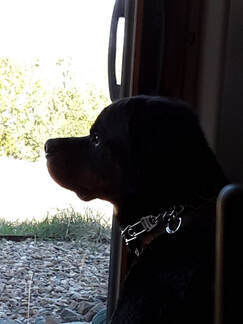 Life imitated life recently, and I got a dog. His name is Panzer, and he is a Rottweiler. My husband and I drove 200 miles to pick him up from a woman in Farmington, New Mexico who specializes in rescuing Rottweilers and other pure breeds.
Life imitated life recently, and I got a dog. His name is Panzer, and he is a Rottweiler. My husband and I drove 200 miles to pick him up from a woman in Farmington, New Mexico who specializes in rescuing Rottweilers and other pure breeds. Panzer is between 1 1/2 and 2 years old, and he acts like a goofy teenager most of the time. He has become my shadow and follows me from room to room. For as big as he is, he is surprisingly gentle and loves little things, including our 15 year old cat (who does not return the love) and our 7 year old granddaughter.
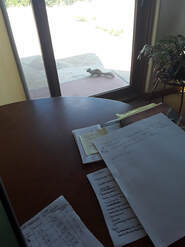 One little thing I'm not so sure Panzer loves is Kamikaze the squirrel. We have lots of squirrels up here in the mountains. We have Antelope Squirrels, which look like very small chipmunks. We have Alberts Squirrels, which are dark gray and have lovely, tufted ears. And we have Rock Squirrels, one of which we've named Kamikaze. This particular squirrel acquired his name because he seems to have no fear. He come up to the glass door in the study, stands on his hind legs and looks Panzer directly in the eye. He runs across the road when Panzer and I are out for a walk. Maybe he wants to be another of Panzer's little friends.
One little thing I'm not so sure Panzer loves is Kamikaze the squirrel. We have lots of squirrels up here in the mountains. We have Antelope Squirrels, which look like very small chipmunks. We have Alberts Squirrels, which are dark gray and have lovely, tufted ears. And we have Rock Squirrels, one of which we've named Kamikaze. This particular squirrel acquired his name because he seems to have no fear. He come up to the glass door in the study, stands on his hind legs and looks Panzer directly in the eye. He runs across the road when Panzer and I are out for a walk. Maybe he wants to be another of Panzer's little friends.
Published on May 04, 2020 00:00
May 2, 2020
Sports in a Time of Quarantine
 Spring is here, and my husband is very unhappy. What is spring without baseball?
Spring is here, and my husband is very unhappy. What is spring without baseball? A lot of people are feeling frustrated over the cancellation of sports due to COVID-19 restrictions. Races cancelled. Little League and kid's soccer put on hold. I am mourning the fact that this spring has seen warm, balmy weather, little wind, and I am NOT out on the track with my runners and throwers. It's been a tough spring.
But if you can't participate in organized sports, at least you can read about them in Super Hec, book 3 of the Anderson Chronicles.
When Mom decides that the Anderson family needs to do a little spring training, she tells everyone that they have to get in shape. Little brother Stevie decides he wants to be a triangle, but signs up for T-ball. Big sister Chloe becomes a yoga enthusiast. Hector has no idea what he should do, but when his friend Eddie loans him an old Superman t-shirt and the guys in the locker room call him Super Geek, Hec decides to become faster than a speeding bully. Can he dig deep and pull up the super powers he needs to run a 5K and win the heart of the girl of his dreams?
If you’ve read Tweet Sarts and Jingle Night, you’ll love seeing what Hec and his wacky family are up to in Super Hec. This is reading the whole family can enjoy - and maybe be inspired to do a little spring training of their own.
Super Hec will be on sale on Amazon from May 2-9. Download a copy and enjoy!
Published on May 02, 2020 00:00
April 9, 2020
My Bad-Weather Flower
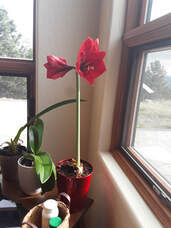 A fair-weather friend is one who stays with you for the good times, but isn't around to support you through the hard times. We all probably have a fair-weather friend, and I am ashamed to say that I've been one before. I can think of numerous friends I let down when they really needed me. It's not something I'm proud of, and I wish I could go back and fix it.
A fair-weather friend is one who stays with you for the good times, but isn't around to support you through the hard times. We all probably have a fair-weather friend, and I am ashamed to say that I've been one before. I can think of numerous friends I let down when they really needed me. It's not something I'm proud of, and I wish I could go back and fix it.I guess the opposite of a fair-weather friend is a bad-weather friend. That would be someone who is willing to weather the storms of life with you, to be by your side when life is painful. I have a few of these, and they are treasures.
 One of my bad-weather friends came and visited me during one of the lowest points in my life. My husband had just lost an election, which meant that he also lost the job that he'd dreamed of for his entire life. It seemed that all our hopes for the future were shattered and we had no idea where to go or how to proceed. Enter said friend, with a boxed amaryllis.
One of my bad-weather friends came and visited me during one of the lowest points in my life. My husband had just lost an election, which meant that he also lost the job that he'd dreamed of for his entire life. It seemed that all our hopes for the future were shattered and we had no idea where to go or how to proceed. Enter said friend, with a boxed amaryllis. The thing about amaryllises, or any other kind of boxed bulb, is they give you something to look forward to. They are hope in a box. But this one had waited too long, and had started to bud while still in the box. It looked pretty hopeless, but it surprised us an bloomed anyway. You can read about it here. But that stubborn little flower wasn't done. It gave us another show after that, which you can read about here.
And now it's blooming again! This is the first time I've ever had a forced bulb repeat. The picture at the top of this post was taken this morning.
This is my bad-weather flower. It seemed to know that this was a hard time, and I needed some cheering up. Here's wishing that you have some bad-weather friends and bad-weather flowers to brighten up your darkest days.
Published on April 09, 2020 10:16
March 30, 2020
William Marshall: A Case Study in the Difficulty of Writing Accurate Historical FICTION
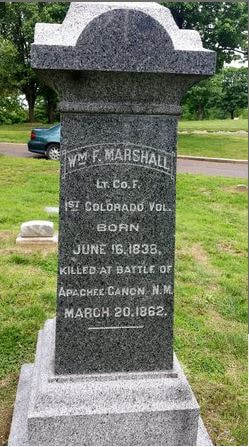 Historical fiction, when written well, has equal parts truth and fiction to it. It not only tells a good story, but helps readers understand a period in time. One of the most interesting and satisfying parts of writing historical fiction is researching the history and portraying it accurately. This can also be one of the most frustrating parts of writing historical fiction, especially when readers point out inaccuracies and anachronisms that in a work. It's happened to me many times. Sometimes the reader is wrong, like the editor who told me that there were no Germans in France during World War II. More often, though, they are right, and I have slipped something in that isn't accurate. Sometimes, however, the problem isn't with a misinformed reader or a gaffe on my part. Sometimes the problem goes farther back than either the writer or the reader. Such is the case with the cause of death for William F. Marshall. There are parts of William F. Marshall's story that we do know. We do know, for instance, that he was elected by the men in Company F of the Colorado Volunteers to the position of 2nd Lieutenant. Several of my readers have questioned this, but it is true that companies elected their officers during this period. We know that he was not universally liked by his men. Some diaries left by men call him imperious or haughty. Finally, we know that he was the last man to die during the Battle of Apache Canyon, the first day and portion of the Battle for Glorieta Pass.
Historical fiction, when written well, has equal parts truth and fiction to it. It not only tells a good story, but helps readers understand a period in time. One of the most interesting and satisfying parts of writing historical fiction is researching the history and portraying it accurately. This can also be one of the most frustrating parts of writing historical fiction, especially when readers point out inaccuracies and anachronisms that in a work. It's happened to me many times. Sometimes the reader is wrong, like the editor who told me that there were no Germans in France during World War II. More often, though, they are right, and I have slipped something in that isn't accurate. Sometimes, however, the problem isn't with a misinformed reader or a gaffe on my part. Sometimes the problem goes farther back than either the writer or the reader. Such is the case with the cause of death for William F. Marshall. There are parts of William F. Marshall's story that we do know. We do know, for instance, that he was elected by the men in Company F of the Colorado Volunteers to the position of 2nd Lieutenant. Several of my readers have questioned this, but it is true that companies elected their officers during this period. We know that he was not universally liked by his men. Some diaries left by men call him imperious or haughty. Finally, we know that he was the last man to die during the Battle of Apache Canyon, the first day and portion of the Battle for Glorieta Pass.
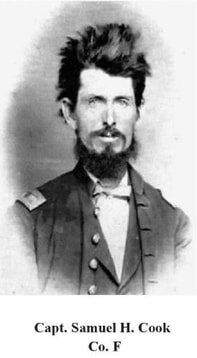 Historical records provide us the names of both the first and the last man shot in the Battle of Apache Canyon. The first was the company's captain, Samuel Cook, who received a buck and ball wound to the thigh. He continued to fight and was injured several times before being carried off the field. He recovered from his wounds.
Historical records provide us the names of both the first and the last man shot in the Battle of Apache Canyon. The first was the company's captain, Samuel Cook, who received a buck and ball wound to the thigh. He continued to fight and was injured several times before being carried off the field. He recovered from his wounds.William Marshall was not so lucky. We know that he was the last man shot on that fateful day. We know that he was carried to Pigeon's Ranch, where a hospital had been established. We know that he died early in the morning of the next day. But the details of his death are sketchy.
The reason the details are sketchy are that the sources we have for this battle are largely military reports or the memoirs of those who were there. Military reports may be very good at telling us who was on the right flank and who led a particular assault. They tell us who died, but they don't include the particulars of that death. Memoirs often tell the particulars, or at least what the veteran who wrote them remembers. One source that I read said that Marshall was supervising the destruction of confederate arms abandoned on the battlefield when he picked up a rifle by its muzzle and hit it against a stump in order to bend the barrel. The gun discharged into his stomach and he died just before dawn of the next day. However, another account tells it differently. According to this man, Marshall took a handgun from a Texas prisoner when it discharged in his face. Face or stomach? Handgun or rifle? While a writer may never be sure, he or she had to choose one story or the other to include in his or her work of historical fiction.
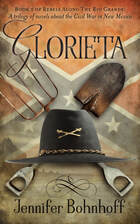 William Marshall's death is part of the story that Jennifer Bohnhoff includes in Glorieta, book two of the series Rebels Along The Rio Grande, which tells the story of the Confederate invasion of New Mexico. A New Mexico native, she hopes she chose the right set of circumstances for the 2nd Lieutenant's death.
William Marshall's death is part of the story that Jennifer Bohnhoff includes in Glorieta, book two of the series Rebels Along The Rio Grande, which tells the story of the Confederate invasion of New Mexico. A New Mexico native, she hopes she chose the right set of circumstances for the 2nd Lieutenant's death.
Published on March 30, 2020 00:00
March 23, 2020
Johnson's Ranch, the Third in Glorieta: The Battle of Three Ranches
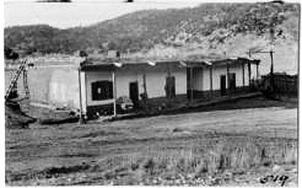 Johnson Ranch, 1917 Three ranches figure prominently in the action surrounding the March 26-28, 1862 Battle of Glorieta Pass. The first was Martin Kozlowski’s ranch. Situated at the eastern entrance of this narrow pass in the mountains east of Santa Fe, this location served as headquarters for the Union Army. The second, Pigeon’s Ranch, sits near the top of the pass and is where the main battle took place. The third site, Johnson’s Ranch, is located at the western end of Glorieta Pass, and was where the Confederate camp was located. All three ranches were also waypoints along the Santa Fe trail, which wended through Glorieta pass before dropping out of the mountains to its western terminus in Santa Fe.
Johnson Ranch, 1917 Three ranches figure prominently in the action surrounding the March 26-28, 1862 Battle of Glorieta Pass. The first was Martin Kozlowski’s ranch. Situated at the eastern entrance of this narrow pass in the mountains east of Santa Fe, this location served as headquarters for the Union Army. The second, Pigeon’s Ranch, sits near the top of the pass and is where the main battle took place. The third site, Johnson’s Ranch, is located at the western end of Glorieta Pass, and was where the Confederate camp was located. All three ranches were also waypoints along the Santa Fe trail, which wended through Glorieta pass before dropping out of the mountains to its western terminus in Santa Fe.Like the other two ranches, the owner of Johnson’s Ranch, a Missouri native named Anthony D. Johnson, was known to be strong Union supporter. At the first appearance of the Southern Army, Johnson took his New Mexican-born wife, Cruz, and their five children, and fled into the hills, where they camped in the frigid weather until it was safe to return home.
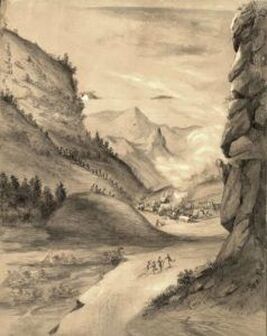 An etching of the burning of the Confederate supply train, with Confederates fleeing toward Santa Fe. If you look closely, you can see a line of Union Soldiers on the left, climbing away from the flames. On March 28, the second day of the battle, Confederate Major Charles L. Pyron and Colonel William thought their camp, far to rear, was safe. Thinking no Union forces could get by them through the narrow pass, they left their 80 supply wagons lightly defended with just one canon and a small contingent of soldiers. Most of the remaining men in camp were either injured or ailing.
An etching of the burning of the Confederate supply train, with Confederates fleeing toward Santa Fe. If you look closely, you can see a line of Union Soldiers on the left, climbing away from the flames. On March 28, the second day of the battle, Confederate Major Charles L. Pyron and Colonel William thought their camp, far to rear, was safe. Thinking no Union forces could get by them through the narrow pass, they left their 80 supply wagons lightly defended with just one canon and a small contingent of soldiers. Most of the remaining men in camp were either injured or ailing.It never occurred to the Confederates that the Union Army could attack their supply train, but that is exactly what Colonel John M. Chivington did. He led a flanking party over Glorieta Mesa, on the south side of the pass. Chivington’s men then climbed down the steep bluff and captured the Confederate guard. They spiked the cannon and burned the Texan supply train. He also ordered that Confederate’s draft mules be bayoneted.
When the Confederate Army, fighting at Pigeon's Ranch, learned the fate of their supply train, the battle ceased. The Confederates began the slow process of withdrawing, first to Santa Fe, then down the Rio Grande to Texas. After the battle, Johnson later testified that after the battle, he was forced to transport sick and wounded Texans back to Santa Fe.
For the Johnson family, the invasion proved an economic disaster. They returned to find that Confederate soldiers had looted the house and ranch. They had taken a barrel of whiskey, ten bags of flour, 20 bushels of corn, sugar, molasses, soap, his clothing, and even his canned oysters. They had burned his furniture and fences as firewood. His house and the stagecoach station had nothing left to them but their bare walls. Johnson filed a claim against the U.S. government for $4,075, but there is no record that his claim was ever paid. Luckily, he had the foresight to drive his cattle into the hills, so he had not lost everything.
Eventually, the Johnsons recovered and got back to the business of operating their stage stop and cantina on the old Santa Fe Trail. He acquired wagons and ran a freight service that hauled goods to and from Fort Union on the edge of the plains. In late 1869, he moved his family to Trinidad, Colorado, just north of Raton Pass. Soon, Johnson hauled ties for the advancing Atchison, Topeka and Santa Fe Railway. In early 1879, Johnson was attacked and killed by highwaymen at a river crossing just east of Springer. His body was never found, and although the culprits were captured and brought before a federal judge in Santa Fe, the trial record has been lost and it is unknown what happened to the highwaymen.
The historic Johnson’s Ranch building lasted nearly 90 years longer than its owner. The building which had been a stage station on the historic Santa Fe trail and sheltered a Confederate Army for a few days was bulldozed in 1967 to make room for Interstate 25, that connects Denver to El Paso. Johnson's Ranch is one of the settings for Jennifer Bohnhoff's historical novel Glorieta, which is available in ebook and paperback. Glorieta is the second in a series of novels about the Civil War in New Mexico. The first is Valverde.
Mrs. Bohnhoff lives in the mountains of central New Mexico. From her north-facing windows she can see Santa Fe and the mountains through which Glorieta Pass travels.
Published on March 23, 2020 00:00
March 16, 2020
GLORIETA, BATTLE OF THREE RANCHES: Pigeon'S RANCH
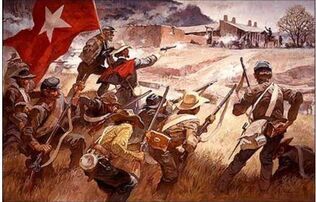 Depiction of The Battle of Glorieta Pass by Roy Anderson The Battle of Glorieta Pass is sometimes called 'The Gettys-burg of the West" because it is the battle that marks the farthest north the Confederate Army got in the New Mexico Campaign. Had H.H. Sibley's forces not been turned back here, they might have taken the Colorado gold fields, then turned west and taken the gold and harbors of California, and the Civil War might have ended very differently. But this battle could easily have been called The Battle of Three Ranches because of where it was fought. The Battle of Glorieta Pass ranged through a narrow mountain divide in the Sangre de Cristo mountains just east of Santa Fe on March 26-28, 1862. The pass was part of the Santa Fe trail that had connected Old Santa Fe to Franklin, Missouri for nearly half a century. The three ranches involved in the battle were also used as way stops along the trail. Three very different characters owned and operated the ranches.
Depiction of The Battle of Glorieta Pass by Roy Anderson The Battle of Glorieta Pass is sometimes called 'The Gettys-burg of the West" because it is the battle that marks the farthest north the Confederate Army got in the New Mexico Campaign. Had H.H. Sibley's forces not been turned back here, they might have taken the Colorado gold fields, then turned west and taken the gold and harbors of California, and the Civil War might have ended very differently. But this battle could easily have been called The Battle of Three Ranches because of where it was fought. The Battle of Glorieta Pass ranged through a narrow mountain divide in the Sangre de Cristo mountains just east of Santa Fe on March 26-28, 1862. The pass was part of the Santa Fe trail that had connected Old Santa Fe to Franklin, Missouri for nearly half a century. The three ranches involved in the battle were also used as way stops along the trail. Three very different characters owned and operated the ranches.Union troops were headquartered at a ranch on the eastern end of the pass that was owned by a Polish immigrant named Kozlowski. You can read more about him and his ranch here.
The Confederate base was at Johnson's ranch, located at the western mouth of the canyon.
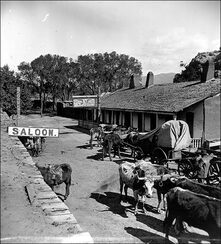 Pigeon's Ranch in the 1880s. Between Kozlowski's and Johnson's place sat Pigeon's ranch, which operated a hotel and saloon and was a popular watering hole along the trail. Pigeon's Ranch was the frequent venue for fandangos, the local dances.
Pigeon's Ranch in the 1880s. Between Kozlowski's and Johnson's place sat Pigeon's ranch, which operated a hotel and saloon and was a popular watering hole along the trail. Pigeon's Ranch was the frequent venue for fandangos, the local dances.Pigeon's ranch was owed by a French immigrant whose very name is a matter of speculation. Some records list him as Alexander Pigeon. Some sources, however, say that Pigeon was a nickname he received because he strutted and flapped his elbows when he danced, making him look rather like a pigeon. On some documents, he is named Alexander Valle. Some historians suggest that Valle is less a surname as a placename given to him because his establishment was in the center of the valley. Both Pigeon and Valle are names that can be found in France, so either may be the man's correct name.
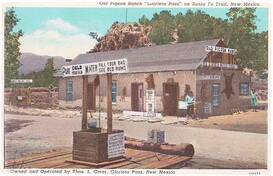 Early in the morning of March 26, a Union scouting party led by Lt. George Nelson encountered and captured a Confederate scouting party near Pigeon's Ranch. The two armies clashed west of the ranch later that day. By nightfall, Union Forces had fallen back to Pigeon's ranch, which had become a hospital for wounded and dying men on both sides. Two days later, the ranch was the center of the battle, its short adobe walls shielding Union soldiers from the oncoming Confederates. In 1986, a mass grave with the skeletons of 31 Confederate soldiers was discovered on the property.
Early in the morning of March 26, a Union scouting party led by Lt. George Nelson encountered and captured a Confederate scouting party near Pigeon's Ranch. The two armies clashed west of the ranch later that day. By nightfall, Union Forces had fallen back to Pigeon's ranch, which had become a hospital for wounded and dying men on both sides. Two days later, the ranch was the center of the battle, its short adobe walls shielding Union soldiers from the oncoming Confederates. In 1986, a mass grave with the skeletons of 31 Confederate soldiers was discovered on the property.
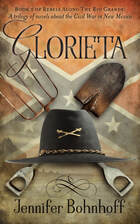 Jennifer Bohnhoff is an educator and author who lives in the mountains of central New Mexico. The view from her backyard includes the Sangre de Cristo mountains. Part of her novel Glorieta, book 2 of the Rebels Along the Rio Grande series, takes place at Pigeon Ranch.
Jennifer Bohnhoff is an educator and author who lives in the mountains of central New Mexico. The view from her backyard includes the Sangre de Cristo mountains. Part of her novel Glorieta, book 2 of the Rebels Along the Rio Grande series, takes place at Pigeon Ranch.
Published on March 16, 2020 00:00
March 9, 2020
Now Available!
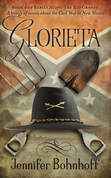 I am pleased to announce that
Glorieta
, book 2 in the Rebels Along the Rio Grande series, is now available in paperback! You can purchase your copy here.
I am pleased to announce that
Glorieta
, book 2 in the Rebels Along the Rio Grande series, is now available in paperback! You can purchase your copy here.If you prefer ebooks to paperbacks, you can pick up your download of Glorieta here.
And if you would rather buy a signed copy directly from the author, you can buy your copy here.
 Glorieta
is the story of two boys. Jemmy Martin is a farm boy from San Antonio, Texas. In
Valverde
, the first book in the series, Jemmy joins H.H. Sibley's Army of New Mexico. Sibley invaded New Mexico in the hopes of conquering the Colorado and California gold fields for the Confederacy and fulfilling a dream of manifest destiny for the south by extending its territory to the Pacific Ocean. He does so not because he has strong Confederate sympathies, but because his brother has sold the family's mules to the Confederate army and he feels the need to protect them and return them home.
Glorieta
is the story of two boys. Jemmy Martin is a farm boy from San Antonio, Texas. In
Valverde
, the first book in the series, Jemmy joins H.H. Sibley's Army of New Mexico. Sibley invaded New Mexico in the hopes of conquering the Colorado and California gold fields for the Confederacy and fulfilling a dream of manifest destiny for the south by extending its territory to the Pacific Ocean. He does so not because he has strong Confederate sympathies, but because his brother has sold the family's mules to the Confederate army and he feels the need to protect them and return them home.  The second boy in Glorieta is Cian Lochlann. Cian came to America with his parents to escape the Irish Potato Famine. The family settled in Boston, but by the time he enters his teens, Cian is an orphan. He travels west to try his luck in the Denver gold boom and then, at the outbreak of the Civil War, enlists in the Colorado Volunteers, who are sent south to stop the Confederates. The two armies, and the two boys, meet in the mountains east of Santa Fe in what becomes known as the Battle of Glorieta Pass. Jemmy and Cian must make a life-changing decision.
The second boy in Glorieta is Cian Lochlann. Cian came to America with his parents to escape the Irish Potato Famine. The family settled in Boston, but by the time he enters his teens, Cian is an orphan. He travels west to try his luck in the Denver gold boom and then, at the outbreak of the Civil War, enlists in the Colorado Volunteers, who are sent south to stop the Confederates. The two armies, and the two boys, meet in the mountains east of Santa Fe in what becomes known as the Battle of Glorieta Pass. Jemmy and Cian must make a life-changing decision.
Published on March 09, 2020 00:00
March 2, 2020
Ordered West: One Soldier's Account of Life in the Territory
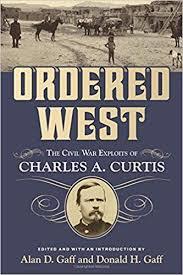 I love writing historical fiction.
I love writing historical fiction. And I really love doing the research. I read over 20 books as I researched Glorieta, the second in my trilogy about the Civil War in New Mexico.
One of the books that I really enjoyed was Ordered West: The Civil War Exploits of Charles A. Curtis.I couldn't use much of what I read in Glorieta; by the time Curtis came to New Mexico in 1862, the Confederates had already lost and were heading back south to Fort Bliss, on their way home to San Antonio. Some of What I read might end up in Peralta, the third and final book in my series.
Charles Curtis came to New Mexico with the 5th United States Infantry. He stayed here on garrison duty until 1865. Years after his service, Curtis wrote a memoir of his time in New Mexico and Arizona while he was president of Norwich University. His memoir was serialized and published in a New England newspaper. Alan and Donald Gaff compiled those stories into a book that is heavily and informatively footnoted so that the reader knows who Curtis is referring to. There are also lots of pictures and maps to help orient the reader.
But what I really found interesting were Curtis' descriptions of places in New Mexico that I could identify. One place he talks about is the aguas termales in the Jemez mountains, hot springs so hot that he claims to have frequently boiled eggs in them.Curtis says that in the river opposite the spring was an island about a hundred feet long and encrusted with sulfur so pure that it would burn when lighted with a match. Anyone who's ever been to the Soda Dam knows exactly what he is talking about. Another interesting episode is the building of winter quarters near Peralta, New Mexico. Curtis describes how the whole command goes into a low area near the river and cuts terrunos (turfs) using axes and spades. The thick, clayey turf is scored with long parallel lines, cut across every nine inches. Each terron was about six inches tall. These were stacked six feet tall, using local mud as mortar to make huts that were the same size as the tents the men used in summer. Stout spars were lashed together and set over the hut and a wall tent was pitched over the top of the spars to make a roof. No windows were necessary since light came through the canvas. Each hut had a wide, open fireplace in the back wall and a wooded door hung on hinges at its front. Curtis says that the alkali soil from which the huts were made dried white and crusty, making the huts look like they were covered with frost. After the hut was made, water was poured on the floors and more dirt added until the floor was a foot higher than the outside. When dry, Curtis said the floor was hard and solid. I have seen lots of pictures of Fort Craig and Fort Union, but this description of how quarters were built really brought the process to life for me.
 Jennifer Bohnhoff is an author and educator who lives in the mountains east of Albuquerque. You can read more about her books here.
Jennifer Bohnhoff is an author and educator who lives in the mountains east of Albuquerque. You can read more about her books here. Ordered West is available from the Albuquerque Public Library, on Amazon, and through independent bookstores.
Published on March 02, 2020 00:00
February 24, 2020
Samuel H. Cook, Miner and Soldier
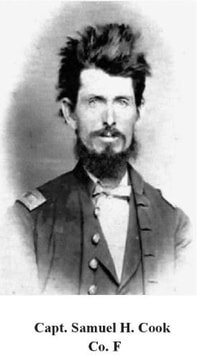 Samuel H. Cook came to the Rockies in 1859 in search of gold.
Samuel H. Cook came to the Rockies in 1859 in search of gold. By summer of 1861, he and his partners, George Nelson, and Luther Wilson, were out money, out of food, and nearly out of hope.
Reading a newspaper near their Golden, Colorado claim, Cook saw an advertisement that stated "the United States Government desperately need troops to wage war and defend itself from secessionist aggression."
The article claimed that any man who could recruit 25 volunteers would be an officer and lead his own troops.
Cook rode the fifteen miles into Denver and had recruiting posters printed. He plastered those posters throughout Rocky Mountain gold mining towns. Men began to show up at his tent to sign up the next day.
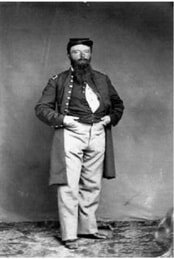 Luther Wilson Cook's first two recruits were his mining partners. George Nelson became Captain Cook's First Lieutenant, and Luther Wilson his Second Lieutenant.
Luther Wilson Cook's first two recruits were his mining partners. George Nelson became Captain Cook's First Lieutenant, and Luther Wilson his Second Lieutenant.But these three were not the only men in the Colorado gold fields who needed a fresh start. The prospect of regular meals, warm clothing, and a comfortable bed attracted many hungry miners from across the region. By mid August, Cook was able to report that he had 87 volunteers ready to ride with him to Kansas to join the Union Army. Cook's old friend, Colonel Jim Lane, wrote back from Leavenworth, Kansas with Cook's appointment, welcoming him.
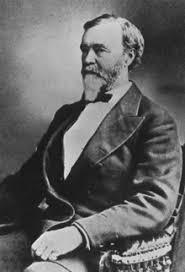 Cook and his men never made it to Kansas.
Cook and his men never made it to Kansas.They stopped for lunch in Denver on the first day of their ride to Kansas, and William Gilpin, the territorial governor, treated Cook to a meal at Sutherland House, one of the fanciest eateries in town. During that meal, Gilpin convinced Cook that the territory needed protection just as much as the Union did, and that he and his men would do well to stay in Colorado.
Cook convinced his men to join the 1st Regiment of the Colorado Volunteers, which Gilpin had appointed Colonel John P. Slough to lead.
Slough wanted to run an infantry regiment, but two of his companies, one of which was Cook's Company F, refused to give up their horses.
Cook is credited with being the first Union casualty in the Battle of Apache Canyon, the name given to the first day of the Battle of Glorieta Pass. He was his three times in the thigh by buck and ball before his horse went down. He survived his wounds.
Samuel Cook, George Nelson, and Luther Wilson are characters in Jennifer Bohnhoff's newest novel, Glorieta. The second in the series of novels about the Civil War in New Mexico, Glorieta continues the story begun in Valverde.
Mrs. Bohnhoff is an educator, historian, and author who lives in the mountains of central New Mexico. You can read about all of her books here.
Published on February 24, 2020 00:00
February 17, 2020
Pike's Peak or Bust!
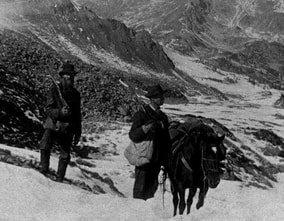 The Pike's Peak Gold Rush, which began a decade after the California Gold Rush, attracted a hundred thousand miners and prospectors to the Pike's Peak Country of western Kansas Territory and southwestern Nebraska Territory. These men were known as the "fifty-niners."
The Pike's Peak Gold Rush, which began a decade after the California Gold Rush, attracted a hundred thousand miners and prospectors to the Pike's Peak Country of western Kansas Territory and southwestern Nebraska Territory. These men were known as the "fifty-niners." Gold was first discovered a decade earlier, in July, 1848 by a group of Cherokee on their way to California over the Cherokee Trail. The Cherokee did not stop to work the stream beds, but they reported their find to members of their tribe. William Green Russell, a Georgian who was married to a Cherokee woman, was working in the California Gold fields when he heard about the reported gold in the Pikes Peak region. He organized a party that included his two brothers and six companions, and in February 1858 they set out for Colorado. They finally hit pay dirt in July at the mouth of Little Dry Creek on the South Platte, in the present-day Denver suburb of Englewood. By the middle of the 1860s, most of the easy to get gold was gone. Placer deposits and shallow hard-rock mines were depleted. Men were giving up by the droves, selling their claims to richer men and companies who had the resources to acquire the materials required to go after ore that was deposited deeper in the ground or to chemically extract gold from mixed ore. Although there was still plenty of gold in them thar hills, the rush was over.
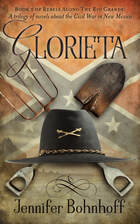 Jennifer Bohnhoff' is an educator and author who lives in the mountains east of Abuquerque, New Mexico. Her newest novel, Glorieta, begins in the gold fields of Colorado. It is now available as an ebook preorder, and will be released on February 26. The paperback will be released in early March.
Jennifer Bohnhoff' is an educator and author who lives in the mountains east of Abuquerque, New Mexico. Her newest novel, Glorieta, begins in the gold fields of Colorado. It is now available as an ebook preorder, and will be released on February 26. The paperback will be released in early March. You can read her short story about mining in Colorado, which features the characters from her novel, here.
Published on February 17, 2020 00:00



